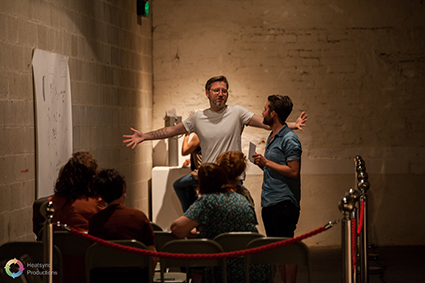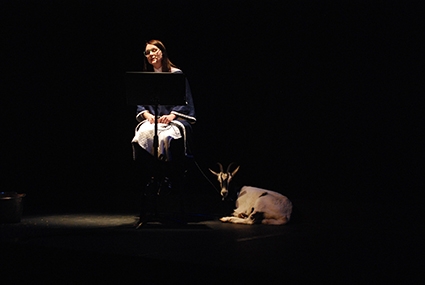New connections, strange directions
Ben Brooker: PADA, Near and Far

101.IS TO 5000.AU, Sandpit /Kviss Búmm Bang performance
photo Jennifer Greer-Holmes
101.IS TO 5000.AU, Sandpit /Kviss Búmm Bang performance
Near and Far is the first public project of Performance & Art Development Agency (PADA), founded by Vitalstatistix Creative Director Emma Webb and Country Arts SA Creative Producer Steve Mayhew. “Exploring distance, time, communication and personal agency” (program), the event—held in Adelaide’s heritage-listed empty shell venue the Queen’s Theatre—presented four new works of wide-ranging and resonantly contemporary form and theme by Australian and international artists, as well as an experimental criticism project and artist talks. Mayhew’s keywords at the event’s opening were “corroboree” and “minimalism,” suggestive of an inclusive, ritualistic celebration of community and live performance in what are increasingly attenuated times for the arts. Webb was more blunt, signalling her prevailing desire for Near and Far to “engage with the fucked up-ness of the world.”
Kviss Búmm Bang
Icelandic participatory art makers Kviss Búmm Bang were not present for 101.IS TO 5000.AU, its running ceded to collaborators Daniel Koerner and Sam Haren of Sandpit. The title references the postcodes of Reykjavik and Adelaide, the two cities the work is designed to bridge through a set of instructions to be completed by audiences. Our first task was to collectively produce a map of Iceland on a large sheet of paper, felt-tip markers and imperfect memories our only aids. I contributed a wild guess as to the location of one of Iceland’s famously large and powerful waterfalls while others doodled the country’s airports, volcanoes and other icons. Meanwhile, audience members were randomly selected to use a rotary-dial telephone to place calls to various Icelandic establishments—hotels, restaurants and so on—for the purpose of discovering more about the country, each caller given a card that suggested a particular line of questioning. The work neatly exposed our ignorance of distant countries. At its conclusion, we bagged up the map for postage via snail mail to Iceland. I can only hope that its recipients’ laughter at our inept effort to map their homeland is cut short by their own realisation of how little they know of ours.
Sarah Rodigari/Josie Were
No doubt Emma Webb programmed Sarah Rodigari’s Reach Out Touch Faith on the strength of her viewing of the work’s first iteration, with Emma Hall performing, at Arts House’s Going Nowhere in 2014 (RT125). Here the work is delegated to Josie Were (and the goat is Eddie, not Cindy) but the text—a performance lecture written in conjunction with UK artist and psychologist Joshua Sofaer about environmental ethics, the outsourcing of live art and our fear of missing out, accompanied by a very present animal—is unchanged. Draped in an airline blanket, Were delivers Rodigari’s monologue perceptively and humorously, veering from the text only to retrieve Eddie whose restlessness sees him dive off the back of the stage to the audience’s alarm. Despite the goat’s best attempts to entirely upstage Were, he fails. Rodigari’s text is a beautiful composition (it would work equally well outside a performance context), scholarly and deeply human, universal and confessional. Constructed in deceptively simple prose, it’s a kind of Freudian sluicing of neuroses around the cost in carbon of the artist’s (necessarily?) jet-setting practice. More broadly, the text dials into ongoing debates about the ontology of delegated performance and the validity of individualistic approaches to mitigating climate change. What is compromised and what made possible when, to invert Marina Abramovic, the artist is not present? It’s a question that will recur more frequently, and with greater import, as the outsourcing of live art continues to abrade old anxieties around authenticity, and as we pass frightening new climate change tipping points.

Josie Were and Eddie, Reach Out Touch Faith
photo Aaron Herczeg
Josie Were and Eddie, Reach Out Touch Faith
Jason Sweeney
The final in a trilogy of ‘quiet’ works, interdisciplinary sound artist Jason Sweeney’s Silent Type, with furniture design by Dale Wright, provided an elegant space for meditation amid the hubbub of the exhibition. Replacing our shoes with hotel-style slippers, we are greeted upon entry with two oversized books laid out for our inspection. Gorgeously minimalistic in design, the books contain dozens of ‘instructions for listening,’ which recall Brian Eno’s famous Oblique Strategies intended to spur creativity and generate lateral thoughts. A typical instruction reads: “Walk towards a window and put your head out into the air. Move your head and listen to the shifting sounds. Try to replace the sounds of cars and people with birds.” In the centre of the space sits a cross-legged, guru-like Sweeney on a round mat, surrounded by the accoutrements of the DJ: twin turntables and a mixer. There are two listening stations with headphones into which Sweeney pipes his nominal set, “a resonant and melancholy collective sound in a space where all that is left are scattered remains, hopeful fragments, sustained chords and distant echoes” (program). In another part of the space a different, deeper kind of introspection is catered for: noise-cancelling headphones lining a circle of wooden benches that surround a group of candles. I slip a pair of headphones on, close my eyes and happily let minutes pass in silence. I don’t fall asleep, as Steve Mayhew encouraged us to do during his opening remarks, but I do appreciate anew the capacity of the quiet to restore and prompt reassessment in our perpetually noisy culture.
Sarah-Jane Norman
Contrastingly, Sarah-Jane Norman’s work-in-progress Stone Tape Theory deploys a complex, nightmarish soundscape to explore memory and trauma. Norman, confined to a darkened space for 30 hours (in six-hour intervals over five successive days), uses analogue tape to record a stream of haphazard recollections from her recent and distant past, broadcast simultaneously into the space over 12 separate channels. Constituting a kind of audio palimpsest, each tape is erased following playback, and another recorded in its place. The result is an eerie, constantly evolving sonic landscape of fragmentary narratives and, finally, auto-decay as the tapes are worn unusably down. The work takes its name from the hypothesis of residual haunting, which posits that inanimate materials such as stone or wood can store and play back, as apparitions of one kind or another, impressions left by traumatic events, asking whether memory itself is not a kind of haunting, a ghostly afterimage of half-remembered experience that lingers within the body. Novel, unsettling and demonstrating fearless commitment from the artist, Stone Tape Theory should progress to full realisation with high hopes.
Jane Howard
Finally, Adelaide-based critic Jane Howard presented Simple Art Transfer Protocol, an experimental criticism and documentary project. Over the exhibition’s five days, Howard engaged via a subscribeable series of email chains with fellow critics Nicole Serratore (New York), Cassie Tongue (Sydney) and Megan Vaughan (London). Using the works in Near and Far as jumping off points, the conversations—passionate, articulate and deeply personal—traversed aesthetics, the state of criticism, diversity and representation in the arts, and much else besides. Howard was also physically present throughout Near and Far, hosting a series of similarly eclectic discussions from behind a desk strewn with performance books and accompanied by a world map on which she progressively plotted the location of her subscribers (not surprisingly, they were concentrated in Adelaide but their range was impressively international). All in all, it was a fascinating, though perhaps conceptually and ethically unresolved, experiment in embedded criticism that was able to generate refreshingly vivid dialogues about art and how we talk about art.
–
PADA, Near and Far, curators & producers Emma Webb, Steve Mayhew, Queen’s Theatre, Adelaide 16-20 Oct
RealTime issue #130 Dec-Jan 2015 pg. 13






